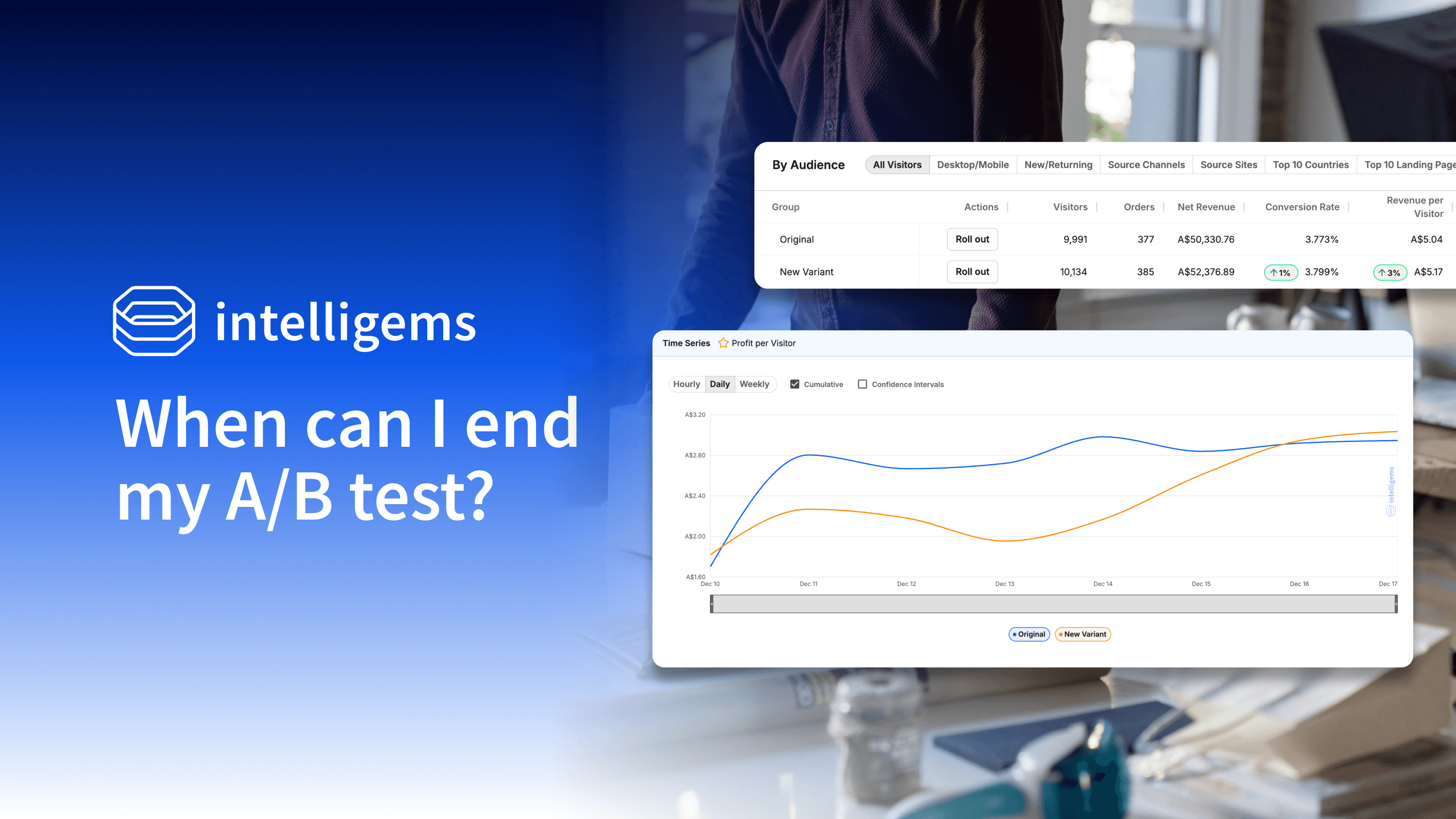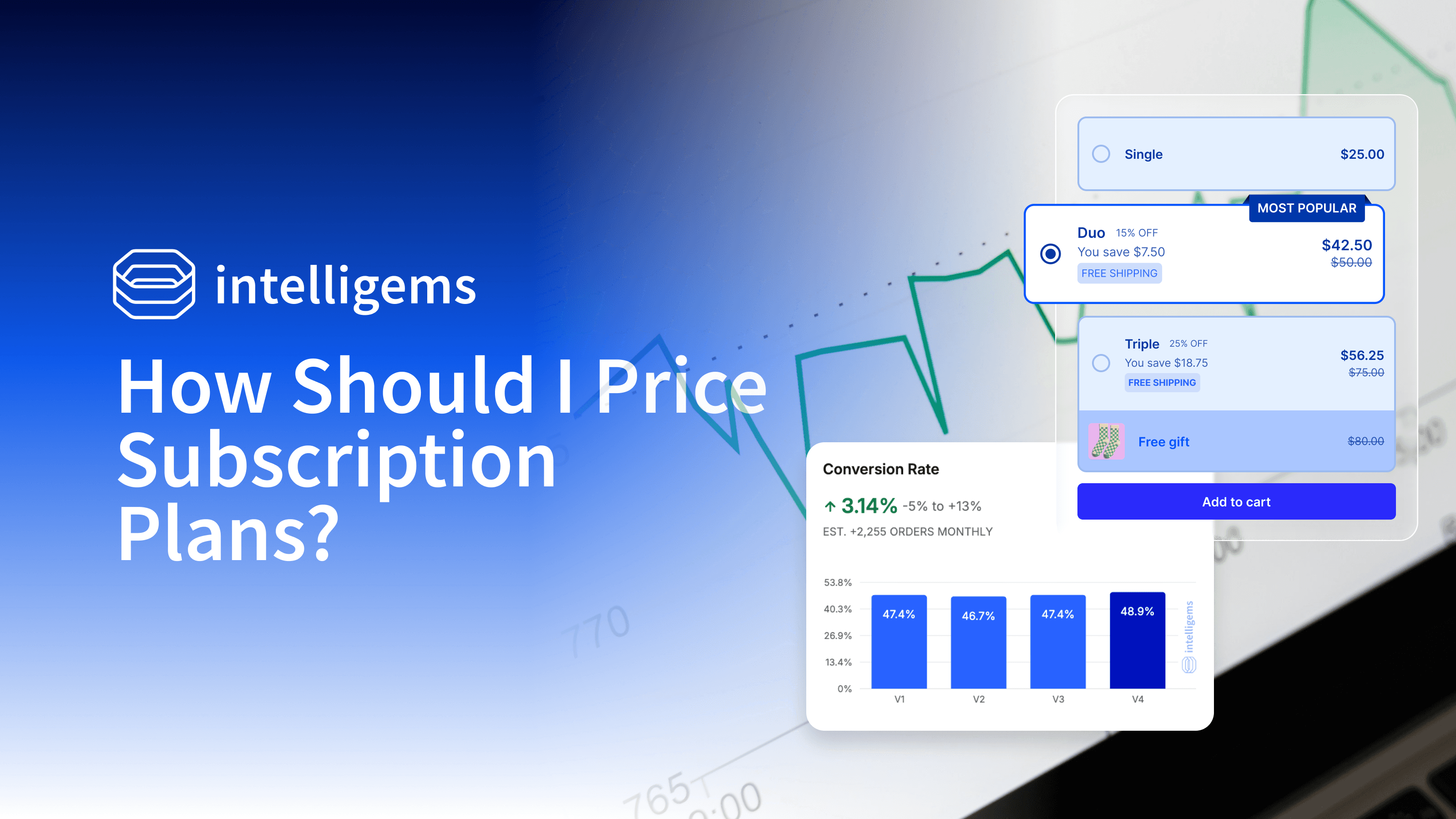AB Testing
Nov 4, 2025
Where Should I Start with Intelligems?
What test gives you the fastest path to real results?
You've installed Intelligems. The dashboard is open. You're looking at price tests, shipping tests, page optimization, promotion testing. Dozens of ways to start learning.
So where do you actually start? What test gives you the fastest path to real results?
We built Intelligems to let you test everything that impacts profit, but the best first step isn't testing everything. It's running two things simultaneously: quick wins on your highest-traffic pages, and one big swing that's close to the money.
Alex and Adam discuss the exact question of where to start on day one, covering the dual-track approach of quick wins and bigger swings.
What should I test on day one?
Every session where you're not testing is a session at potentially suboptimal performance. The cost isn't just what you're paying for the tool. It's the revenue you're leaving on the table while you figure out the perfect starting point.
The answer: run two types of tests at the same time.
The Two-Track Approach
Here's how to maximize learning speed and impact from day one.
Quick wins: Small optimizations in rapid succession on high-traffic pages. Change a headline. Test a hero image. Route traffic differently. Fast to set up, fast to read, and they build your testing muscle.
Big swings: Beyond-the-page tests that happen close to the money. Shipping rates, pricing, thresholds. These have real potential to move profit per visitor.
Why both? Small tests alone won't transform your business. Big tests alone mean you're not building testing momentum. Run them simultaneously and you get quick wins while bigger tests run in the background.
Quick Wins on High-Traffic Pages
Start where the traffic is. Small changes on high-traffic pages create outsized impact.
Where are you sending ad traffic?
Pull your analytics: Collection page? Product page? Homepage? That's your testing ground. More traffic means faster results and clearer signal.
What can you test right now?
Pick something simple you control:
Change the headline
Test a different hero image
Route traffic to different pages (collection vs. product page vs. homepage)
That last one is powerful because it requires zero design work. You're just redirecting traffic to pages that already exist. Can you convert more people by sending them directly to your bestseller's product page instead of the collection?
How many tests should you queue up?
Three minimum. When your first test finishes, immediately launch the next one. No downtime between tests. This is how you build momentum.
One Big Swing Close to the Money
While quick tests run, launch something bigger that happens near the decision point.
Shipping rate test
Test charging more for shipping. Shipping happens at checkout when people decide to purchase. As close to the money as you can get. It's low risk (you're not changing your product) and every dollar increase goes straight to profit if conversion holds.
Learn how one brand increased profit per visitor by 10% by testing shipping rates. The surprising winner was $4.99, not free shipping, showing how customers perceive value differently than you might expect.
Price test
Test higher or lower prices on your bestsellers. This is your biggest profit lever. You'll see exactly how price changes impact profit per visitor, not just conversion. Example: If you're selling at $100, test $105 and $110. Sometimes higher prices with slightly lower conversion drive significantly more profit per visitor than the original price.
Learn the fundamentals of price testing, including the straddle approach (testing 5-10% above and below current prices), why profit per visitor is your north star metric, and how to iterate on your findings.
Volume discount or gift with purchase
Test incentives that increase basket size. "Buy 2, Save 10%" or "Free gift at $75" can raise average order value while maintaining good margins. Example: Test whether offering 15% off orders over $100 increases profit per visitor more than your current discount structure.
What metric actually matters?
Focus on profit per visitor across all three test types.
Profit per visitor = (Revenue - Costs) ÷ Total visitors
Conversion might shift, but profit per visitor tells you if you're actually winning.

Pro Tips for Day One Success
Start where you have control, queue tests, track profit
Now that you know what to test, here's how to get the most value from day one.
Start where you have the most control. Avoid tests that need sign-offs from marketing, design, and your CEO. Pick areas where you control the changes and can launch today.
Don't wait for perfect. Starting is the goal, not perfect test design. You'll learn more from running an imperfect test than planning one that never launches.
Queue your next tests now. Have three tests planned before you start. When one finishes, launch the next immediately. No gaps, no waiting.
Run both tracks simultaneously. Quick wins show immediate value. Your shipping rate test runs for two weeks and shows profit impact. You're learning fast on both fronts.
Track profit per visitor, not just conversion. Conversion might increase while margins compress. Only profit per visitor tells you if you're actually winning.
How to Get Started
Launch your first two tests in under 30 minutes
Step 1: Identify your highest-traffic page. Check your analytics. Where are you sending most ad traffic? That's where you'll run quick tests.
Step 2: Pick your first quick test. Choose something you control that requires no approvals. Change a headline, test a new hero image, or route traffic to a different page. Set it up and launch.
Step 3: Queue tests 2 and 3. Don't wait. Plan your next two quick tests right now so you have zero downtime when test #1 finishes.
Step 4: Launch your shipping rate test. If you're currently charging customers $5 for shipping, test $6 or $7. Track profit per visitor, not just conversion rate.
Step 5: Run for 2-3 weeks. Let patterns stabilize. Different days bring different behavior. After 2-3 weeks, you'll have clear signal on both tracks.
Step 6: Act on your wins. Roll out winning variations. Start your next tests. Build momentum. You're now in a testing rhythm that compounds learning over time.
Ready to get started and see what small changes and big swings can do for your business? When you're ready to start testing, let's get you testing beyond what's typical.
AB Testing
AB Testing
AB Testing







